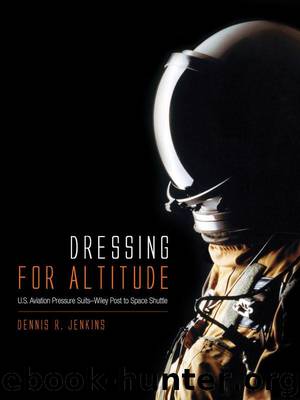Dressing for Altitude by Dennis R. Jenkins

Author:Dennis R. Jenkins
Language: eng
Format: mobi, epub
Tags: pressure suits, altitude, suits, NASA, dressing, Wiley Post
Publisher: NASA
Published: 2012-08-30T04:00:00+00:00
Image credit: Courtesy of the David Clark Company, Inc.
The Model 18 was another attempt to provide a large dome that could cover a standard flying helmet and oxygen mask. The pressure suit itself incorporated many improvements and evaluators were generally impressed with the flexibility and comfort. Like the attempts before it, the size of the helmet proved a major impediment to the suit’s use in operational aircraft.
The Model 14 was essentially a Model 12 sized to fit Charles C. Lutz of the USAF Aero Medical Laboratory at Wright Field as part of an exchange of ideas relating to pressure suits. The Model 15 was a similar suit intended for LCDR Roland A. Bosee at the NACEL, but the suit was cancelled before it was completed for unexplained reasons.50
By March 1952, David Clark Company had developed a completely airtight shoulder bearing that eliminated some of the manufacturing issues with the original cloth-covered ball bearing units, but the company was unable to incorporate the change into the Crossfield and Carl suits because of timing. David Clark Company had also simplified the construction of the cloth knee and elbow bellows joints without sacrificing mobility and had begun experimenting with insulating the outer layer of the pressure suit with reflective foil. The Minnesota Mining and Manufacturing Company, later called 3M, was developing a special technique to coat the spun-nylon waffle fabric with a silver metallic layer.51
Unfortunately, the Navy contract ran out of funds in April 1952, effectively ending large-scale development work on full-pressure suits at the David Clark Company. The Navy found sufficient funds to continue a minor effort at David Clark Company, resulting in continued support for the couple of suits used at Edwards and for the fabrication of several derivative suits for further research.
For example, on July 7, the NACA High-Speed Flight Station at Edwards requested several changes to Scott Crossfield’s Model 12 suit. These included new arm sections, different zippers, redesigned disconnect and check valves for the breathing regulator, the relocation of the breathing regulator, a redesigned helmet lens, and the manufacture of a special parachute pack and harness. David Clark Company completed these changes in September 1952, and the Navy tested the suit in the NACEL altitude chamber in October 1952.52
The Model 16, sized to fit LCDR L. Harry Peck from the NACEL, incorporated some of the changes recommended by Marion Carl. David Clark Company delivered the suit to the Navy on January 12, 1953. The suit consisted of a rubberized fabric inner bladder, a nylon waffle-weave outer restraining garment, and a nylon outer coverall. A pressure-sealing slide fastener opened circumferentially around the chest, and a waist gusset allowed the suit to be configured for standing or sitting by opening or closing a nonpressure sealing zipper on the outside of the suit. Rotatable, nonpressure sealing rings were located at the neck, shoulders, and wrists. The close-fitting headpiece used a pressure-sealing slide fastener, a removable faceplate, and a manually accessible oronasal opening. The suit weighed 16 pounds without the Firewel combined compensated regulator or other accessories.
Download
This site does not store any files on its server. We only index and link to content provided by other sites. Please contact the content providers to delete copyright contents if any and email us, we'll remove relevant links or contents immediately.
| Automotive | Engineering |
| Transportation |
Whiskies Galore by Ian Buxton(41509)
Introduction to Aircraft Design (Cambridge Aerospace Series) by John P. Fielding(32876)
Small Unmanned Fixed-wing Aircraft Design by Andrew J. Keane Andras Sobester James P. Scanlan & András Sóbester & James P. Scanlan(32558)
Craft Beer for the Homebrewer by Michael Agnew(17917)
Turbulence by E. J. Noyes(7682)
The Complete Stick Figure Physics Tutorials by Allen Sarah(7122)
Kaplan MCAT General Chemistry Review by Kaplan(6570)
The Thirst by Nesbo Jo(6422)
Bad Blood by John Carreyrou(6260)
Modelling of Convective Heat and Mass Transfer in Rotating Flows by Igor V. Shevchuk(6216)
Learning SQL by Alan Beaulieu(6012)
Weapons of Math Destruction by Cathy O'Neil(5805)
Man-made Catastrophes and Risk Information Concealment by Dmitry Chernov & Didier Sornette(5629)
Digital Minimalism by Cal Newport;(5356)
Life 3.0: Being Human in the Age of Artificial Intelligence by Tegmark Max(5166)
iGen by Jean M. Twenge(5143)
Secrets of Antigravity Propulsion: Tesla, UFOs, and Classified Aerospace Technology by Ph.D. Paul A. Laviolette(4907)
Design of Trajectory Optimization Approach for Space Maneuver Vehicle Skip Entry Problems by Runqi Chai & Al Savvaris & Antonios Tsourdos & Senchun Chai(4833)
Electronic Devices & Circuits by Jacob Millman & Christos C. Halkias(4729)
